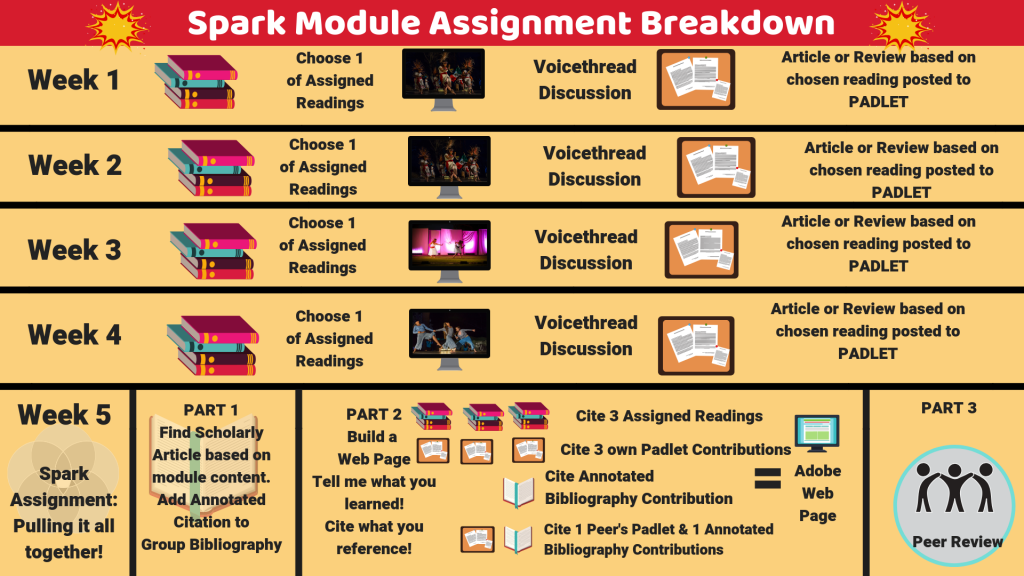A Brief Background
The Dance in History course is taught online and fulfills the multi-cultural and/or art GE requirement. It is an important class for Performing Arts Dance Emphasis Majors, but the majority of the students come from diverse disciplines and backgrounds. When I survey students at the start of the semester most admit they took the class for two reasons
- It fulfilled a requirement.
- It was online.
Challenge accepted. As a dance studies scholar I see where dance connects to everything, but how do I help my students understand the pervasiveness of dance globally and how it has value in their studies and lives? My answer, I give them the freedom and the agency to make those connections for themselves.
How Text Book Free and Student Choice Opened the Door for Integration
I break down my course into three modules with each one culminating in an extensive writing assignment where the students explain what they have learned. For each week of the module, students have three requirements:
- Choose from one of the assigned readings.
- I have 3-5 selections they can choose from with a short description.
- Curate a scholarly journal, newspaper review or article that the student relates to their reading of choice. They have to cite the article and connect the article to their reaching choice. They are encouraged to think broadly and critically, ask questions, and make connections to their various studies and life.
- Participate in the VoiceThread
When I opened my mind to the true power of student agency and choice, I realized I can offer several reading choices surrounding a particular lens in dance. This allows me to demonstrate the global impact of dance through display of the reading choices and provide the students with agency and empowerment over their learning. After the students read and curate content, they participate in the VoiceThread where the overall theme and each individual article is discussed. Students explain the article they chose to read and in addition, they have more information to contribute to the lecture because of the curation assignment. Students in nursing, biology, psychology, ESRM, chicana/o studies, communication and more explain how dance and the particular lens of the week relates back to their field of study or interests in life. I find myself learning in the course I am teaching.
For this blog I created an anonymous survey asking students how they felt about the structure of the course, here are some of their responses:
“I really enjoy these assignments because each student gets to pick the reading they are interested in so it creates a more diverse discussion for the Padlet and VoiceThread.”
“It makes it relevant because it adds critical thinking skills to see how two or more topics tie in together and it helps create a more open-minded, big picture.”
“This new approach is less stressful and more engaging, and actually drives us to want to learn/study more.”
Connecting the Dots
One of the most exciting exchanges in my class was when a student of biology connected a swing dance video with “the displays of dominance in the model organism, Drosophila melanogaster (the fruit fly).” Giving students agency and encouragement to curate a sophisticated and relatable learning experience through OER would not have been possible at this magnitude a decade ago.
Education used to be more siloed, integration was fostered through team taught courses and projects, and more students had the luxury of exploring the curriculum. Today, with pathways to completion more clear and team taught courses are offered less, how do we foster the integrative mind? I offer the idea of curation, choice, and student agency through OER as a possible pathway.

Example of reading selections as they are presented to the students:
- Jeyasingh, Shobana. “Imaginary Homelands: Creating a New Dance Language.” the Routledge Dance Studies Reader, edited by Alexandra Carter, 1998, pp. 46-52
- This article discusses how author and London Based Choreographer Shobana Jeyasingh identifies with both her Indian heritage and her heritage growing up in the UK and the artistic expectations that are placed on her culturally by her place of birth
- Shobana Jeyasingh Website
- Murphy, Jacqueline Shea. “Dancing in the Here and Now.” The Oxford Handbook of Dance and Politics, edited by Rekekah J. Kowal, Gerald Siegmund, Randy Martin, 2017, pp. 535‐558
- This article by UCLA World Arts and Culture Professor and native scholar Jacqueline Shea Murphy discusses two different companies that are performing contemporary indigenous dance.
- Dancing Earth, the dance company featured in the article.
- Catalyst Dance, the company Emily Johnson runs and is also featured in the article.
- “Lessons in Dance (as) History: Aboriginal Land Claims and Aboriginal Dance, circa 1999,” Dancing Bodies Living Histories: New Writings about Dance and Culture, ed. Anne Flynn and Lisa Doolittle, Banff Centre Press, 2000.
- This article written in 1999 by Jacqueline Shea Murphy at the early stages of her academic career as a white female who was a native scholar. She speaks about what she learned about dance history on a visit to BANFF cultural center in Canada.
- Muriel Miguel video talking about her life as an artist. She choreographing the piece Throw Away Kids discussed in the article.
- Shapiro-Phim, Toni. “Mediating Cambodian History, The Sacred, and The Earth.” Dance, Human Rights, and Social Justice: Dignity in Motion, edited by Naomi Jackon, Toni Shapiro-Phim, 2008. 304-322
- This article by Toni Shapiro-Phim discusses how Cambodian refugees found “place” in dance, when they were disconnected from their “land” during the Khmer Rouge occupation in the 70s and 80s.
- This is a website that talks about cultural restoration after the conflict in Cambodia.